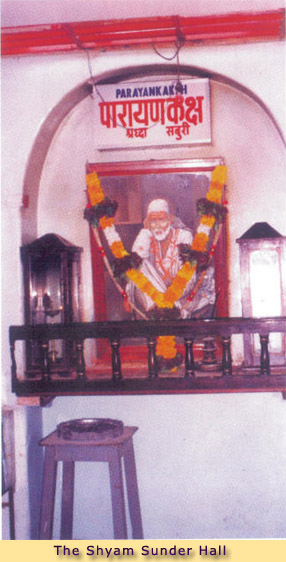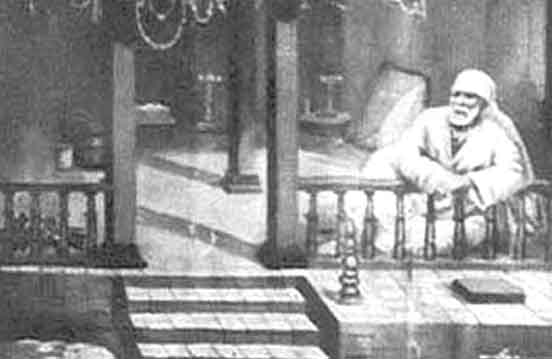Sree Dwarakamyi Detailed
Saibaba lived in Dwarakamai for 60 Years
Shirdi Sai baba gave blessings to devotees for 60 years from this place
WHY DWARAKAMAI?
"This is our Dwarakamai where you are sitting. She wards off all dangers and
anxieties of the children who sit on her lap". “Mashidimayee is her name.
Will she ever go back on her promise?” said Baba to Bala Saheb Mirikar who
was going to Chitali, and was to have an encounter with a serpent (Ref. ESS,
XXII).
A Mother is always full of love and tenderly merciful towards her
child. Mashid or Ma+Shi+da means refuge at the feet of Lord Shiva. In Shirdi
the Parabrahma gave refuge and is still giving refuge to the multitudes of
devotees that flock there.
The word Dwaraka can be broken into Dwar+Ka. Dwar means the door and
Ka means Brahman. Thus, it is the door or the gateway to get to or reach
Brahman. Dwaraka is that place where one can get freedom from the bondage of
Karmic actions. Dwaraka is also known as Mukthidham and Mokshapuri.
It was here that Baba spent 60 years in bliss. Here Baba granted his
devotees wishes, and nurtured them like the mother tortoise. Finally, he
took Maha Samadhi in his beloved Mashidimayee.
Baba's words are always true. Then why did Baba call this Masjid
'Dwarakamai"? One can geographically, historically, mythologically place
Dwaraka at Shirdi.
1. The Churning of Kshirsagar
The story of churning the Kshirasagar goes like this. It was agreed by the
Gods and Demons that whoever accepted the Halahal (poison) was also able to
partake of the Ambrosia (Amrit). Lord Shiva drank the Halahal and it was
made to stop in His throat. Thus He earned the name "THIRU NEEL KANTESHWAR"
and the place of occurrence got the name "GHAT SIRAS" (taluq: Parthardi, SE
of Shirdi).
After the Halahal, Ambrosia came into creation and the Gods partook
of it. Chandra (Moon) and Surya (Sun) came to know that Rahu and Kethu
stealthily came to the God's side and partook the Ambrosia. They quickly
informed Lord Vishnu about this. Vishnu came in the disguise of the
beautiful Mohini and dazzled Rahu and Kethu and then cut the head of Rahu
with her golden chakra. The place where Rahu's body was thrown is called
Rahuri (about 45 kms from Shirdi) where a temple is said to exist. The place
of occurrence is called Mohini Raj (Arda Nari Nateshwar temple at Newasa;
110 km SE of Shirdi). Kethu's bodyless head fell in Kethu temple at
Rathangad (60 km NW of Rahuri). The nectar that flowed out of Kethu's mouth
at Rathangad became the exalted Parwara river. This river was originally
known as Amrit Vahini (carrier of nectar).
Out of the 14 Ratnas (jewels), Lord Shiva took Halahal, Ambrosia and
Chandra. The place of Chandra is now called Chandgoan (about 130 kms from
Shirdi) where Chandreshwar temple is. Lord Krishna took Devi Lakshmi,
Kausthab (gold making bell), Shank and Dhanur. Lord Indra took Airavatam,
Kamadhenu, Rambha, Parijatham and Dhanvantari (Ashvini Kumar), the place is
called Belapur (25 kms from Shirdi). The Bilveshwar Mandir is there. The
place of Ashvini Kumar is called Ashvi (20 km from Shirdi). Lord Surya took
the seven headed horse and the place is called Kolhar (45 kms from Shirdi).
2. The Yadav dynasty
As late as 12th and 13Ih century, Yadav (Lord Krishna's dynasty) ruled most
of present Maharashtra. Their capital was Devgad Fort near Aurangabad
mentioned in the Dhyaneshwari.
Rukmini, the wife of Lord Krishna, was born at Kundipur, Amravati
district, near Nagpur. Her father ohishmak, was a king and his capital was
Devgad near Fort Aurangabad.
3. Pandharpur
The southern most tip of Dwaraka is situated in Sholapur district (450 kms
from Shirdi). The story of Pundalik is as follows:
Once Rukmini left Lord Krishna in a huff. Krishna went after her to
pacify her. He roamed the Dhandrivan forest, found and pacified her. On His
way He saw Pundalik doing ardent seva to his parents. On seeing the Lord,
Pundalik threw a brick and asked Krishna to sit a while, till he had
finished. The Lord stood on the brick and waited with astonishment arms
akimbo. The Lord was pleased at the selfless seva and said to Pundalik 'ask
for a boon'. Pundalik unhesitantly asked the L
4. Gopal Kala
Lord Krishna practiced Gopal Kala (parched rice mixed with curds etc. in an
earthen pot). Baba too mixed all the food in the Kolamba and partook of it
and distributed it to all. Gopal Kala is performed by the Sansthan on the
completion of all ceremonies at Shirdi.
5. Our Dwarakamai
The best explanation is given in English Sai Satcharitra Ch. IV. Definition
of Dwaraka quoted from Skanda Purana 'The place where the doors are open for
all people regardless of caste, community and creed, for accomplishing
Dharma, Artha, Kama, and Moksha is called Dwaraka'-Baba's Masjid in Shirdi
is open to one and all.
The sanctum sanctorum is closed at about 9 p.m., while the
Sabhamandap is left open throughout the night. Before the sanctum sanctorum
is closed it is swept and cleaned, a zaari full of water is placed in front
of Baba’s photograph, the mosquito net is hung around the photograph and a
lit Kandil (lantern) is hung above the Kathada or railing.
In 1996, this Kandil started swinging; many devotees felt that it
was an omen, others felt that some great change, or event was about to take
place in Shirdi. Many devotees gathered around to behold the event, the
place of the Kandil was changed, yet the swinging did not stop. This
happened for about a week, the only event that occurred was that Sivanesan
Swamiji died on 12th February 1996. He loved the Dwarakamai and from the
early 1960’s looked after it with tender and loving care
What did this Masjid look like?
This Masjid that Baba extolled was old and dilapidated. There were deep pits
and huge holes in the floor. Each and every nook and corner had garbage
dumped in it. It was in this ambience that he stayed, blissfully smoking his
Chillim, by day and night. To appease his hunger he took Bhiksha (Alms) from
five houses. Whether the food was stale or delicious he did not bother.
On his body were torn and tattered clothes, and it was impossible
for the people to recognize his divinity. Often he roamed in the forests
nearby. There he would sit under the Babul Tree (a small tree full of
thorns), often talking to some unknown entity and waving his hands about in
a threatening manner. The villagers saw his lifestyle and took little notice
of him.
A Mother is always full of love and tenderly merciful towards her child. Mashid or Ma+Shi+da means refuge at the feet of Lord Shiva. In Shirdi the Parabrahma gave refuge and is still giving refuge to the multitudes of devotees that flock there.
The word Dwaraka can be broken into Dwar+Ka. Dwar means the door and Ka means Brahman. Thus, it is the door or the gateway to get to or reach Brahman. Dwaraka is that place where one can get freedom from the bondage of Karmic actions. Dwaraka is also known as Mukthidham and Mokshapuri.
It was here that Baba spent 60 years in bliss. Here Baba granted his devotees wishes, and nurtured them like the mother tortoise. Finally, he took Maha Samadhi in his beloved Mashidimayee.
Baba's words are always true. Then why did Baba call this Masjid 'Dwarakamai"? One can geographically, historically, mythologically place Dwaraka at Shirdi.
After the Halahal, Ambrosia came into creation and the Gods partook of it. Chandra (Moon) and Surya (Sun) came to know that Rahu and Kethu stealthily came to the God's side and partook the Ambrosia. They quickly informed Lord Vishnu about this. Vishnu came in the disguise of the beautiful Mohini and dazzled Rahu and Kethu and then cut the head of Rahu with her golden chakra. The place where Rahu's body was thrown is called Rahuri (about 45 kms from Shirdi) where a temple is said to exist. The place of occurrence is called Mohini Raj (Arda Nari Nateshwar temple at Newasa; 110 km SE of Shirdi). Kethu's bodyless head fell in Kethu temple at Rathangad (60 km NW of Rahuri). The nectar that flowed out of Kethu's mouth at Rathangad became the exalted Parwara river. This river was originally known as Amrit Vahini (carrier of nectar).
Out of the 14 Ratnas (jewels), Lord Shiva took Halahal, Ambrosia and Chandra. The place of Chandra is now called Chandgoan (about 130 kms from Shirdi) where Chandreshwar temple is. Lord Krishna took Devi Lakshmi, Kausthab (gold making bell), Shank and Dhanur. Lord Indra took Airavatam, Kamadhenu, Rambha, Parijatham and Dhanvantari (Ashvini Kumar), the place is called Belapur (25 kms from Shirdi). The Bilveshwar Mandir is there. The place of Ashvini Kumar is called Ashvi (20 km from Shirdi). Lord Surya took the seven headed horse and the place is called Kolhar (45 kms from Shirdi).
Rukmini, the wife of Lord Krishna, was born at Kundipur, Amravati district, near Nagpur. Her father ohishmak, was a king and his capital was Devgad near Fort Aurangabad.
Once Rukmini left Lord Krishna in a huff. Krishna went after her to pacify her. He roamed the Dhandrivan forest, found and pacified her. On His way He saw Pundalik doing ardent seva to his parents. On seeing the Lord, Pundalik threw a brick and asked Krishna to sit a while, till he had finished. The Lord stood on the brick and waited with astonishment arms akimbo. The Lord was pleased at the selfless seva and said to Pundalik 'ask for a boon'. Pundalik unhesitantly asked the L
The sanctum sanctorum is closed at about 9 p.m., while the Sabhamandap is left open throughout the night. Before the sanctum sanctorum is closed it is swept and cleaned, a zaari full of water is placed in front of Baba’s photograph, the mosquito net is hung around the photograph and a lit Kandil (lantern) is hung above the Kathada or railing.
In 1996, this Kandil started swinging; many devotees felt that it was an omen, others felt that some great change, or event was about to take place in Shirdi. Many devotees gathered around to behold the event, the place of the Kandil was changed, yet the swinging did not stop. This happened for about a week, the only event that occurred was that Sivanesan Swamiji died on 12th February 1996. He loved the Dwarakamai and from the early 1960’s looked after it with tender and loving care
On his body were torn and tattered clothes, and it was impossible for the people to recognize his divinity. Often he roamed in the forests nearby. There he would sit under the Babul Tree (a small tree full of thorns), often talking to some unknown entity and waving his hands about in a threatening manner. The villagers saw his lifestyle and took little notice of him.
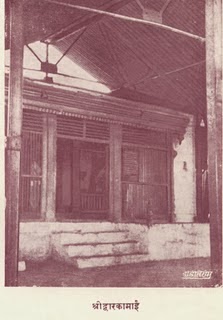
The only time they interacted with him was when someone in the family was
sick and they needed some medicines. Baba dispensed his medicines readily.
If the patient did not recover quickly, he himself went and nursed him back
to health.
Baba’s divinity dawned on the villagers only after Nana Sahib
Chandorkar’s visits to Shirdi. He was convinced of Baba’s superhuman powers
and divinity although, Gangagiri Maharaj had told the villagers “He is a
valuable diamond lying in a heap of rubbish. It is your good fortune that he
has come to stay amongst you”.
The Sadguru manifests to uplift his devotees. His only concern is
their welfare in every aspect of life. He is eager that they progress
spiritually and that they are filled with love, and bliss. The devotees are
also eager to do Guru Seva, charitable deeds, and fulfill his wishes.
The Repair of the Masjid
Nana Sahib’s heart was bursting with love and devotion. He was eager to
renovate and repair the old and dilapidated Masjid. His only thought was
“How will I get permission to make the Masjid more habitable?”. Baba However
was quite content, and did not grant him permission. Nonetheless with this
thought in his mind he went to Shirdi.
The next morning Nana was standing outside the Masjid and waiting
for Mahalsapati, who had done to get his Bhiksha. Having received it, he was
about to enter the Masjid, when Nana accosted him. Nana was eager to tell
him of his plan. At that very moment Baba called out to Mahalsapati.
Mahalsapti immediately went to Baba, who said, “Arre Bhagat, who is
standing outside?”. Mahalsapti told him that it was Nana Sahib Chandorkar.
Innocently Baba said, “Is that so? Bhagat I wanted to have your opinion on
this matter. That Nana says, “Baba I would like to build a new Masjid”. Now
don’t you think our old Masjid is good enough for us?”. To this Mahalsapati
replied, “Baba let him build a new Masjid. It will be very useful for both
of us, as we will have a place to sit, and to sleep when the time comes”.
Then Baba agreed and gave his consent.
As soon as Baba gave his consent, Mahalsapati called out to Nana,
and asked him to start the work. Nana immediately brought a coconut and
broke it. Thus, on Mahalsapati’s advice Nana Sahib Chandorkar was allowed to
renovate the Masjid. And Kaka Saheb Dixit was allowed to do the flooring.
(Refer “Shiladhi” by Dr.Keshav B Gavankar).
The three carpenter brothers Kondaji, Gabaji and Tukaram Sutar
provided the greatest help in the repair of Masjid. All the woodwork was
done by them. After the renovation the management of the Masjid continued
with them for many years. Till Baba’s Mahasamadhi, Tukaram undertook the
sweeping of the Masjid. He took care of Baba’s needs like heating water, and
giving it to Baba to wash his face and mouth. Baba would not allow any other
person to do this. (Refer “Shri Sai Baba of Shirdi” by the Late Rao Bahadur
M.W.Pradhan).
The Sabhamandap (1911) – Extension of Dwarakamai
The area in front of the Dwaraka Mai was a vacant plot. The devotees stood
there and attended the Aratis, often in the scorching heat and rain. Dixit
thought that if a Sabhamandap or portico was built, then it would provide
shelter for the devotees from the elements. He was determined to build it no
matter what it cost.
Gopal Gund who started the Urs thought that he should repair the
Masjid. But that job was for Nana Chandorkar, and the pavement work for
Dixit. Permission at first was not granted, but, on the intervention of
Mahalsapathi, it was granted. Dixit wanted to extend the space in front of
the Masjid so that the devotees could use it. He bought tall iron pillars,
and angled brackets. On the day that Baba slept in the Chavadi, he and the
other devotees worked all night. The next morning when Baba came to the
Dwarakamai Mai he swiftly pulled out the pillars. In 1911 this Sabha Mandap
was put in order with great efforts. In Sai Satcharitra, Chapter 6, a
detailed account is given under “the renovation of the Masjid and
construction of the Sabha Mandap”.
An incident is mentioned, how Baba caught hold of one post with one
hand and Tatya's neck with the other hand and shook both. Then taking
Tatya's pheta He burnt it offering one rupee from His pocket. Seeing this
strange behaviour none dared to intervene. After cooling down He brought one
beautiful embroidered pheta and Himself tied it on Tatya's head. As if Tatya
was being given a special honour. (Ref. ESS, Ch.VI).
After this incident Baba allowed the work to go on smoothly and thus
the devotees had a place for worshipping Baba. The pavilion is still there
where the devotees can see, and participate in the worship of Baba and also
touch the sacred articles used by Baba.
Thanks to Dixit’s dedication and determination. The devotees now can
enjoy its comfort. In this Mandap many Palkis stop for a while. Devotees use
it for exchanging garlands on their weddings, for christening ceremonies and
Anna Prashana (the ceremony of solid food being given to the child). But
most importantly, devotees recite the Vishnu Sahasranama, Do Baba’s Naam
Jap, and read the Sai Satcharitra.
Thus, the Dwarakamai Mai had two parts, the Sanctum Sanctorum which
is the Masjid or Dwarakamai Mai and the Sabha Mandap.
The Sanctum Sanctorum or Dwarakamai Mai faces east. Three steps lead
to the inside. The three steps are 17’ in length and 15’ in breadth.
The entrance to the Sabha Mandap faces south. The roof has CI
corrugated tin sheets. These sheets were donated by Baba’s ardent devotee
Capt.Darruwala as a gesture of gratitude. Through his mysterious ways Baba
saved him, his crew and some ships from the enemy during the Russo-Japanese
war of 1905. The roof is supported by 12 iron pillars, 15’ long.
There are small niches in the eastern wall, seven on the right, and
ten on the left, of the shrine that houses Baba’s photograph. In the past,
devotees used to place lighted Diyas (earthen lamps) as Baba loved to light
Diyas. The length of the Sabha Mandap is about 48’ from the Platform to the
Shrine, and the breadth is 38’.
There is a room that shares its eastern wall of the Sabha Mandap.
Its door faces east. The signboard above it reads, “Shyam Sunder Hall”.
Dwarakamai in the 1920s
Each and every article present in the Dwarakamai fills the devotee’s heart with love, joy and peace. Baba spent 60 years here. His touch has filled every stone, brick and woodwork with life. This is the place where he fondly asked about each devotee’s welfare, and told stories. Like a fond mother he fed the devotees sweets. Sometimes he cut fruits into small pieces and put small morsels into their mouth.
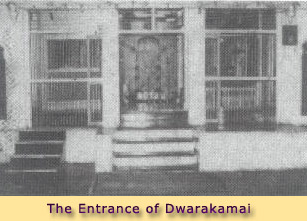
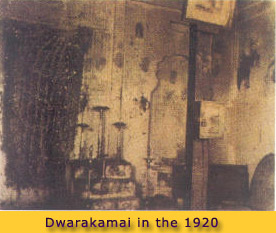
In the place that he sat there was a hug portrait painted by Shamrao R
Jaykar that faces the south. Now a copy of that portrait is there, and the
original portrait is kept on the first floor of the Museum inside temple
complex. This masterpiece is so much famous that it’s often referred to as
the Dwarakamai Mai Baba Photograph. Below this portrait was a Chappi (a wet
cloth that is wound around the end of the Chillim) and a Chillim. A set of
marble Padukas were installed directly in front of the portrait for the
devotees to Namaskar. The Nimbar was garlanded daily and draped with a
beautiful shawl. Next to it were the three ever burning lamps. The lamps are
still there. There were two Grinding Mills next to the lamps. Baba used the
Bigger Grinding Mill when he ground wheat to drive away the cholera epidemic
that had spread widely in Shirdi village. He used the smaller one to grind
pulses, and spices when he wanted to do Annadaan. Beside the lamps was, and
still is, a sack filled with wheat.
To the left, in the alcove was the clay Maath (water pot). In the
corner near the math were a stack of Chillims that are now in the museum.
Next to these were Baba’s Bhiksha utensils, like the Tumrel and Kolamba. The
Tumrels are now kept in the museum. In front was the open Dhuni Mai. Then a
small wall was erected around it and the Dhuni Mai was enclosed. In a
cupboard next to the Dhuni Mai heaps of Baba’s Kafnis were neatly folded and
stored. Now, Baba’s Kafni is hung in the museum. (Refer “Shiladhi” by
Dr.Keshav B Gavankar).
At present the cupboard is used to store Baba’s Alankar items like
Chandan, Ashtagandh and Kumkum. In the cupboard on the left, the articles
that he needs for the night are stored. These articles are the Mosquito Net,
the Copper Kalasha for water, and a Phool Patra (this is a flat bottomed,
copper tumbler that is kept over the mouth of the Kalasha) and the Kerosene
Oil Lantern.
In 1959 the Shirdi Saibaba Sansthan made some more renovations. In
1998 the Sansthan redid the Dhuni Mai, and laid heat resistant bricks at the
base. They also made a Chimney. While this work was going on for a few days,
the Jyot (Fire) was maintained in a small, temporary Dhuni Mai.
The door number of Dwarakamai Masjid allotted by Shirdi Municipal
Corporation is 778. This can be seen on the left side of the wall present
next to the main entrance of Dwarakamai.
THE BELL
This huge brass bell tied above, and to the left of the entrance of Dwarakamai pavilion was tied by Baba. It is not the original bell and has been changed many times. It is rung only three times a day, at 4.00 AM, 11.30 AM and 8.30 PM. It is rung by the Pujari of Dwarakamai, calling the devotees for Arati. If it is rung untimely, it signals an untoward incident has taken place somewhere in the village. The people will assemble in the pavilion, and then go to the place of the calamity and set it right. This practice is still going on; hence its gong is tied to the grill.
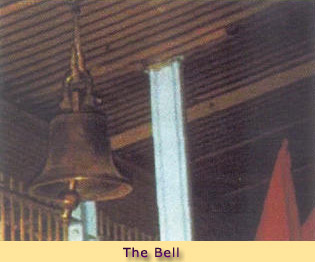
Mention is made in Sai Satcharitra Ch.XIX. When Baba sent Hemadpanth (Dhabolkar) to Shyama's house to get Rs.15/- Dakshina, and sit and chit chat with him, Shyama told him the story of Radhabai Deshmukh, and the two paise of Dakshina meaning “Sraddha and Saburi”. Just as Shyama finished the story, the bell of the Masjid started to ring proclaiming that the noon worship and the Arati had begun and both hurried to the Masjid for the noon Arati.
THE FLAGS (NISHANS) OF THE DWARAKA MAI
Gopal Rao Gund was devoted to Baba. He did not have any children, but with
Baba’s blessings a son was born to him. He felt that an annual Yatra (fair)
should be held in Shirdi. He told the prominent devotees of Shirdi, like Tatya
Kote, Dada Patil and Shyama about it. They all liked the idea very much and
everyone started making preparations for it. However the Kulkarni (the Revenue
Officer) opposed it. Hence the District Collector did not grant them permission
to hold the fair. But they single mindedly pursued it, and finally got
permission to hold the fair.
They chose the festival of Ramanavami to hold the fair. Tatya Kote Patil
supervised all the arrangements. Gopal Rao Gund who started the Urs (Ramanavami
celebrations) in Shirdi, asked his friend Damu Anna Rasne to supply a flag for
the occasion. He also induced Nana Saheb Nimonkar to supply another embroidered
flag. Both these flags were taken in procession, through the village to the
accompaniment of musical instruments. Then these flags were fixed atop the roof
of Dwarakamai. (Ref. ESS, Ch. VI).
Even today, this tradition is still being carried out by their
descendants. The great grandson of Damu Anna Rasne, Pradeep Rasne brings an
ochre coloured flag. He along with his family comes from Ahmednagar. While the
great grandson of Nana Sahib Nimonkar, Chandrakant Deshpande Nimonkar brings a
green coloured flag from Pune.
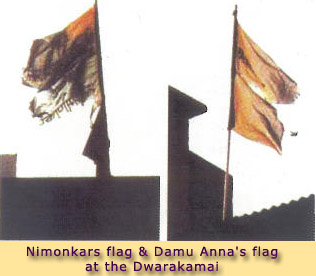
Even now the flags brought by the descendants of Damu Anna and Nimonkar are
first placed on the Samadhi. Arati is performed, then taken to the home of
Tukaram by the Sansthan. Again Arati is done, the flags are hoisted on the staff
(pole) prepared by the descendants of the three brothers. Then with great joy
and ceremony it is taken in procession throughout the village and hoisted on the
roof of the Dwarakamai (Ref. Shri Sai Baba of Shirdi by Late Rao Bahadur
Moreshwar W Pradhan).
The gheru flags on the southern wall of Dwarakamai are provided by the
Sansthan.
The significance of the Flags or Dhwaja or Nishan
The hosting of Flags is a common feature in all Hindu Temples. The
Dhwaja or Flag are made of cloth and are hoisted atop temples, taken by
Padayatris to holy places like Phandarpur and Shirdi. The temple or place of
worship is considered as the palace of deity. He is the emperor of emperors and
to honour him the flags are hoisted. Flags denote the area of territory of a
particular ruler or a country. Similarly, the flags of the Dwarakamai Mai
indicate the place of the Parabramha Shri Samartha Sadguru Shirdi Saibaba.
THE SMALL RED PILLAR:
The small red pillar is in front of the Chulli. Baba used to sit in front of the
Chulli while cooking, and rested his back against this pillar. Whenever Baba
went out of the Sanctum Sanctorum, he did Pradakshina to this pillar, and also
when he returned. Pradakshina is done of a temple, or a sacred book or a holy
tree. A devotee can do the same and get the benefit from this sacred pillar.
The unique feature of this pillar is that if anyone who has pain in the
back or joints, leans against it, the pain abates. Many a devotee can be seen
leaning against it. Some devotees read the Shri Sai Satcharitra, others sing the
Aarti leaning against it. Others meditate close to it.
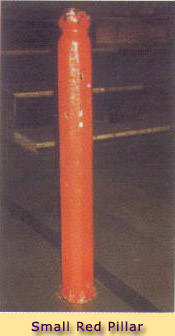 Nana Sahib Dengle was an ardent devotee of Saibaba. Once he wanted to do formal
worship to Baba. So he came with all the puja materials and sought Baba’s
permission. But, Baba refused and asked him to do the ritual to this pillar.
Every morning the Pujari of Dwarakamai applies Asthagandh ( a mixture of sandal
wood powder and saffron powder) to this pillar.
Nana Sahib Dengle was an ardent devotee of Saibaba. Once he wanted to do formal
worship to Baba. So he came with all the puja materials and sought Baba’s
permission. But, Baba refused and asked him to do the ritual to this pillar.
Every morning the Pujari of Dwarakamai applies Asthagandh ( a mixture of sandal
wood powder and saffron powder) to this pillar.
Now a grill enclosure has been built around it for its preservation.

THREE STEPS IN FRONT OF THE PILLAR
These three steps on the southern side of the Dwarakamai, were used by Baba to
go out and come into the Sanctum Sanctorum. Devotees are requested to offer
namaskar to the above steps as Baba used them.
The significance of the three steps of the Dwarakamai Mai:
The three steps represent the three Gunas. These trigunas refer to three
fundamental components of Prakriti or Maya. This is the basic matrix of which
this universe is created. These trigunas are Satva, Rajas and Tamas. These gunas
are not qualities or attributes, but they are fundamental subtle elements which
constitute Prakriti, like the cords of a rope. They bind the jeevatma to the
body.
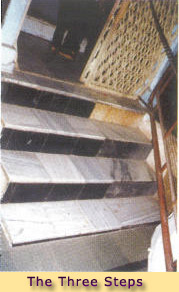 Satva increases when the other two decrease. It is characterized by right
knowledge, purity, happiness, and righteous actions, etc. Thus after death, they
take us to higher worlds.
Satva increases when the other two decrease. It is characterized by right
knowledge, purity, happiness, and righteous actions, etc. Thus after death, they
take us to higher worlds.
Rajas, when it increase the other two are low. It provides a
thirst for selfish actions, anger, greed, lust, involvement, suffering, and
egoism. After death it brings the Jeeva back to earth.
Tamas increases when the other two are low. It is characterized
by ignorance, dullness, sloth and sin. After death the jeeva goes to the lower
worlds.
To reach the Parabrahma one has to be gunatita. This is possible by
doing sadhana, under the tutelage of the Sadguru. But for his grace this is next
to impossible. Therefore, one has to rise above the trigunas to establish the
pure Satva or “Self”. This can be accomplished by treating the pair of opposites
with equanimity, by remaining unconcerned about losses or gains etc. i.e., by
remaining calmly aloof, and above all being totally surrendered to him.
Thereby, one by climbing the three steps of the Dwarakamai Mai will
reach the state of attributeless Parabrahma.
PADUKAS IN FRONT OF CHARIOT ROOM
Every morning Baba stood here leaning against the wall, while He looked at
the sun. In remembrance of this, two sets of Padukas; (1) small Padukas are
on the southern wall. This is where Baba placed His hand while leaning
against the wall; and (2) just below the small Padukas, is a small shrine
enclosing a bigger set of Padukas. This is the site of Baba's holy charan
(sacred feet).
Daily worship is done by the Pujari of Dwarakamai with ashtagandh.
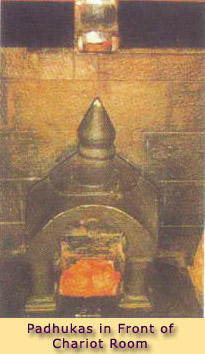
THE CHULLI
The Chulli is a semicircular earthen hearth or oven. Small faggots of wood
are placed in its cavity and lit, while the Handi or Utensil is placed on
top of the rim. This Chulli is directly in front of the red pillar, in the
Sabhamandap.
The Shastras prescribe charity for all the woes of the Kali Yuga. Of
all forms of charity, Anna Daan is the highest, as every one feels the pangs
of hunger. As Baba took a Saguna Roopa, he also did Anna Daan. Whenever Baba
wanted to do Anna Daan He used this Chulli for preparing the food, and the
devotees joyfully ate the Prasad. There were two copper Handies, a smaller
one could feed 50 people. The other could feed a hundred people to satiation
with some food remaining.
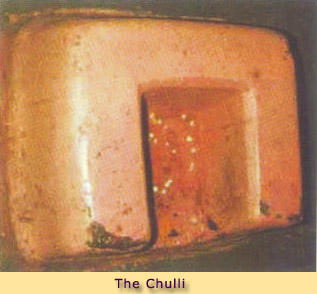
When Baba decided to cook He was very meticulous about the salt, condiments,
garnishing and other ingredients. He would go to the grocer, and the market
place, and buy exactly what was required and paid in cash. He himself ground
the wheat, pulses or jowari on the quern, and then prepared the food.
Baba would often prepare meatha chawal, mutton pulav (spicy rice
with bits of mutton in it), varan (soup like lentil or dal) with wheat
dumplings or Moong daal dumplings and ambli. Often times instead of a ladle
He would pull up the sleeve of His Kafni and churn the contents with his
bare hands. Yet there was no trace of burns or scalding on His hands.
After the food was cooked to his satisfaction He would carry it to
the Masjid (sanctum sanctorum) of Dwarakamai. The Maulavi would offer Fatiah
or prayers, to the food with proper ritual. Then Baba would send the Prasad
to homes of Mahalsapathi and Tathya. The remaining food, Baba served the
people assembled there to their utmost satisfaction. "Have some more, take
some more" He lovingly said (ESS, Ch.XXXVIII).
These Quern (hand mill) and the handies used by Baba, are now kept
in the Museum.
THE CHARIOT (RATH) ROOM
This room is on the left side, of the main entrance to Dwarakamai. The old
chariot used to be kept in it. This chariot was presented to Baba by Avasthi
and Rege. The first procession was taken on Gurupurnima of 1918. The
devotees entreated Baba for permission and Baba reluctantly agreed to the
procession. But Baba never sat in this chariot.
Previously, Sivanesan Swamiji , an ardent devotee of Baba, who with
his tireless efforts cleaned and beautified the Dwarakamai, was allotted
this room by the Sansthan and he stayed in this room for many years. Later
this room was used to store containers of hot Udi before it was sieved. The
chariot was then taken and kept in the extension of the Samadhi Mandir. Now,
the right wall has small trap doors so the Udi is shoveled directly into
trays from the Dhuni Maa.
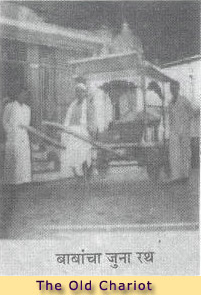
The rest of the room is used to store sacks of Gowri (Cow Dug Cakes) and
logs of wood to feed the Dhuni Maa. The Chariot was kept for sometime in the
extension of the Samadhi Mandir. After the Museum was built this only
original rath which is from Baba’s time has been housed in the hall on the
ground floor of the Museum.
THE DHUNI MAA
The everlasting Dhuni lit by Baba Himself more than 150 years ago, is still
burning. The word 'Dhuni' possibly comes from the root word 'Dhun' meaning
'to kindle or waft'. Even during the cholera epidemic, when the Panchayats
ordained that no fuel cart should be allowed to come in the village, Baba
went to the fuel cart and bought wood for his Dhuni. Baba went at regular
intervals to the forest nearby and carried huge logs of wood for his Dhuni.
The smoke and soot that emitted from the Dhuni Maa and touched or covered
the devotees seated there was akin to Bhasma Snan. Like an Agnihotri,
keeping his sacred fire alive, throughout his life Baba kept this Dhuni ever
burning all day and night (Ref. ESS, XXIII).
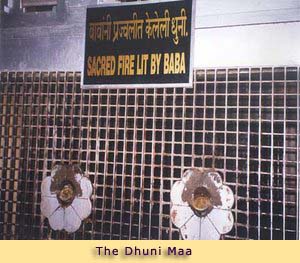
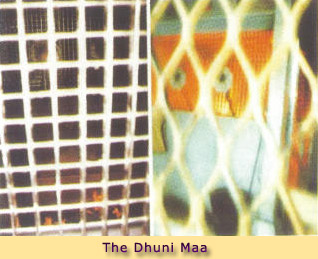
When Baba slept in the Chavadi, Radhakrishna Aai cleaned, and whitewashed
the Masjid. She had to take out all the things including the Dhuni and
replace it as it was (Ref. ESS, Ch. VI).
At first Baba practiced medicine and became famous as a Hakim. Later
He stopped giving medicines, but gave Udi instead.
Baba's all omnipresence and mercy saved the blacksmith's child from
a horrible death in the furnace. On Shyama's concern, and questioning Baba
replied "When the child slipped into the furnace, I immediately thrust my
hand and saved the child. I do not mind my arm being burnt, but I ain glad
that the life of the child is saved". What intense mercy and love for His
Bhaktas! This incident bestowed Baba's favour on Bhagoji Shinde, who daily
massaged and bandaged it till Baba's Mahasamadhi (Ref. ESS, Ch. VII).
Every morning Baba sat in front of this Dhuni. He seemed to be
offering into the Dhuni oblations of the ego, desires, and all thoughts.
'Allah Mallik', 'Allah Mallik' He softly said (Ref. ESS, Ch.V).
Sitting by the Dhuni Baba often spoke of the distant places He went
to overnight and what He had done. Those who slept by His side the whole
night at the Dwarakamai knew that His physical body was in Shirdi. But these
statements were occasionally verified and found to be true by Prof. Narke
and also others.
The Dhuni is 7’ long and 5’2’’ wide. Devotees offer wood, gowri,
ghee, nav dhanya and five types of wood to this sacred Dhuni. In the early
days, the Dhuni Puja was done by the individual devotee. But, now with the
heavy turnout of devotees from all over the world to Shirdi, the Dhuni puja
cannot be done by the individual devotees as the Dhuni is boarded with a
mesh. This is a precaution taken by the Sansthan in order to preserve Dhuni
Maa’s sanctity, as devotees used to put the loban along with the plastic
wrapper, and other undesirable articles to the sacred fire. A huge drum is
placed near the Dhuni to enable devotees to place their offerings in it and
it is later offered to the Dhuni by the priest.
The Dhuni Puja is done daily at about 11 a.m. by the Sansthan.
Eleven coconuts, wood, gowri are offered to Dhuni Maa at this time. The
priest from the Samadhi Mandir does Vaishva Deva (Agni) Puja with Anna Ahuti
(cooked rice mixed with ghee), as was done during Baba’s time by Sagun Meru
Naik upon Baba's instructions.
In our daily lives we kill a lot of insects, flies and mosquitoes,
thus accumulating a lot of sins. To get ablution from these sins we should
feed, the agni, the ants with sugar, feed the dog, the crow and the cow. It
is often impossible to do this and hence Baba in his mercy did this for us.
The Sansthan is doing it for us every day by performing the Vaishva Deva
Puja.

Daily worship is done by the Pujari of Dwarakamai with ashtagandh.

The Shastras prescribe charity for all the woes of the Kali Yuga. Of all forms of charity, Anna Daan is the highest, as every one feels the pangs of hunger. As Baba took a Saguna Roopa, he also did Anna Daan. Whenever Baba wanted to do Anna Daan He used this Chulli for preparing the food, and the devotees joyfully ate the Prasad. There were two copper Handies, a smaller one could feed 50 people. The other could feed a hundred people to satiation with some food remaining.

Baba would often prepare meatha chawal, mutton pulav (spicy rice with bits of mutton in it), varan (soup like lentil or dal) with wheat dumplings or Moong daal dumplings and ambli. Often times instead of a ladle He would pull up the sleeve of His Kafni and churn the contents with his bare hands. Yet there was no trace of burns or scalding on His hands.
After the food was cooked to his satisfaction He would carry it to the Masjid (sanctum sanctorum) of Dwarakamai. The Maulavi would offer Fatiah or prayers, to the food with proper ritual. Then Baba would send the Prasad to homes of Mahalsapathi and Tathya. The remaining food, Baba served the people assembled there to their utmost satisfaction. "Have some more, take some more" He lovingly said (ESS, Ch.XXXVIII).
These Quern (hand mill) and the handies used by Baba, are now kept in the Museum.
Previously, Sivanesan Swamiji , an ardent devotee of Baba, who with his tireless efforts cleaned and beautified the Dwarakamai, was allotted this room by the Sansthan and he stayed in this room for many years. Later this room was used to store containers of hot Udi before it was sieved. The chariot was then taken and kept in the extension of the Samadhi Mandir. Now, the right wall has small trap doors so the Udi is shoveled directly into trays from the Dhuni Maa.



At first Baba practiced medicine and became famous as a Hakim. Later He stopped giving medicines, but gave Udi instead.
Baba's all omnipresence and mercy saved the blacksmith's child from a horrible death in the furnace. On Shyama's concern, and questioning Baba replied "When the child slipped into the furnace, I immediately thrust my hand and saved the child. I do not mind my arm being burnt, but I ain glad that the life of the child is saved". What intense mercy and love for His Bhaktas! This incident bestowed Baba's favour on Bhagoji Shinde, who daily massaged and bandaged it till Baba's Mahasamadhi (Ref. ESS, Ch. VII).
Every morning Baba sat in front of this Dhuni. He seemed to be offering into the Dhuni oblations of the ego, desires, and all thoughts. 'Allah Mallik', 'Allah Mallik' He softly said (Ref. ESS, Ch.V).
Sitting by the Dhuni Baba often spoke of the distant places He went to overnight and what He had done. Those who slept by His side the whole night at the Dwarakamai knew that His physical body was in Shirdi. But these statements were occasionally verified and found to be true by Prof. Narke and also others.
The Dhuni is 7’ long and 5’2’’ wide. Devotees offer wood, gowri, ghee, nav dhanya and five types of wood to this sacred Dhuni. In the early days, the Dhuni Puja was done by the individual devotee. But, now with the heavy turnout of devotees from all over the world to Shirdi, the Dhuni puja cannot be done by the individual devotees as the Dhuni is boarded with a mesh. This is a precaution taken by the Sansthan in order to preserve Dhuni Maa’s sanctity, as devotees used to put the loban along with the plastic wrapper, and other undesirable articles to the sacred fire. A huge drum is placed near the Dhuni to enable devotees to place their offerings in it and it is later offered to the Dhuni by the priest.
The Dhuni Puja is done daily at about 11 a.m. by the Sansthan. Eleven coconuts, wood, gowri are offered to Dhuni Maa at this time. The priest from the Samadhi Mandir does Vaishva Deva (Agni) Puja with Anna Ahuti (cooked rice mixed with ghee), as was done during Baba’s time by Sagun Meru Naik upon Baba's instructions.
In our daily lives we kill a lot of insects, flies and mosquitoes, thus accumulating a lot of sins. To get ablution from these sins we should feed, the agni, the ants with sugar, feed the dog, the crow and the cow. It is often impossible to do this and hence Baba in his mercy did this for us. The Sansthan is doing it for us every day by performing the Vaishva Deva Puja.
THE SMALL SILVER PADUKAS IN FRONT OF DHUNI MAA
These small silver Padukas are in the North West corner, and in front of the Dhuni Maa. It is the sacred place where Baba sat every morning before 5.00 AM for about an hour. This hour Baba spent in solitude. At that time other devotees were not allowed to approach Baba, except for the Sevkaries who quietly came and swept the Dwarakamai. Bhagoji Shinde was the first devotee to go to Baba and massage his burnt hand.
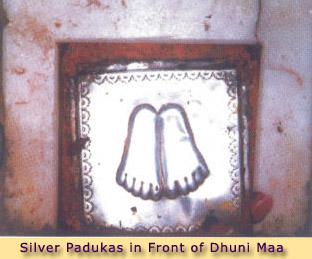
THE PUJA PILLAR
Baba sat near the pillar, which is adjacent to the small Silver Padukas. Baba
always sat straight and did not rest his back against the pillar. Baba was very
fond of the pillar and asked many devotees to perform Puja to it. The details
are as follows:
In the year 1908, Tatya Saheb Nulkar, who was a sub judge in Pandharpur
came to stay in Shirdi. Baba asked him to stay in the Chavadi.
One day, in the morning Baba told Shama, “Ask Mhatara (old man) to
perform Puja to the pillar”. Shama went and told Nulkar (Mhatara) exactly what
Baba had said. Both of them discussed the reason for this, but could not come up
with an answer. At last they consulted the almanac, and found that it was Vyas
Purnima or Guru Purnima. But Baba had asked him to perform puja to the pillar,
and not to him. Nonetheless they were happy that at least he had allowed puja to
be performed in the Dwaraka Mai. Nulkar was performing puja to the pillar when
Shama turned up. Baba said, “Why is he performing puja all by himself? Why can’t
you too perform the puja?”. Shama replied “I will not perform puja to this
pillar. But if you will allow me to perform pooja to you, I will gladly do so. I
will only worship you and not this or any other pillar”. After a lot of debate
and discussion, Baba finally agreed.
Dada Kelkar was aware that it was Guru Purnima, so he sent for Tatya who
had gone to his farm. Both of them went with puja materials, and performed Guru
Puja. The rest of the devotees present in Dwaraka Mai followed suite. They
offered fruits, dakshina and vastra (dhotis) to their Guru. The dhoti was of no
use to Baba but they got the opportunity to do Guru Puja that day and they hoped
that it would continue in the future.
Thus the festival of Guru Purnima started, and now it is celebrated as a
three day function by the Sansthan. On the first day there is Akhand Parayan,
the second day is the main festival and it concludes on the third day with Gopal
Kaala. Guru Purnima is celebrated in the Ashada Masa (June-July).
The meaning of “Baba Sitting in Front of Dhuni Maa”
There is also an original photograph of Baba sitting in front of Dhuni Maa taken
during Baba’s period.

This pose possibly represents the “inward journey” that we have to take to
reach “Baba”, and be one with him. This journey started with the first step
of withdrawing our Karmendriyaas totally from this mundane life. This is
represented by the left leg which is not seen.
Control the Jnanendriyaas, which are to act over the Karmendriyaas
which is represented by the right leg over the left leg.
This is achieved by following the messages heard or insight derived
from this inward journey. This is represented by the closed fist of the
right hand which is kept next to the ear. An invisible Antakarna Chatushtaya
with adhimanas as support is represented by the right hand kept next to the
right ear.
The left hand over the right leg represents surrendering to him in
totality. We have to surrender all of the following, the three Shariras, the
trigunas, the arishadvargas, the 5 pranas, and the 5 koshas. This is
achieved by following the Jnana Marga, Bhakti Marga, Karma Marga or the
blend of these three.
THE KOLAMBA
This Kolamba is an earthen container which was used by Baba to mix the food
received by Bhiksha.
Baba used to take Biksha from five blessed houses daily. He called
out "Oh. Lassie give me a piece of bread". He begged three to four times a
day till noon, but His Biksha was erratic and irregular (Ref. ESS, Ch.VIII).
This mixture known as Kala would then be distributed to numerous devotees,
birds, cats and dogs and Baba did not drive them away. Baba himself ate very
little of the remaining food. This practice of Biksha went on till His
Mahasamadhi. If He could not go He deputed someone else like Vamanrao Patel
or G.G. Narke.
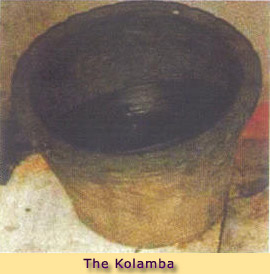
The significance of the Kolamba lies in the fact that it is made of clay and
thus may break at any time. Just as the human body is transient and death
may strike at any moment the body also acts as a container to mix the
various acts of life. These actions and their consequences are akin to the
food got by begging from our own doings. The taste of the food may be sweet
(happiness) or sour (sorrow). Baba by mixing the food is teaching us to
receive the happenings in our lives with equanimity.
The food will taste sweet, sour or bitter as long as it is in
contact with the tongue. Once it crosses the tongue no taste is experienced,
as there are no separate compartments in the digestive system. For the
digestive system different types of food are the same for it to conduct its
function.
The tongue is the most important organ of our body. We do all kinds
of deeds just to fill its needs not only for ourselves but for our
generations to come. Everyone is busy trying to amass wealth, when we are
not sure of our very own existence, thus becoming a slave to passions,
thereby hiding the real “self”.
Baba is teaching us not to become a slave of the tongue. Having the
tongue under our control, we can march towards the supreme.
The Pujari from Samadhi Mandir comes and offers Bhog to Baba twice a
day, and leaves some Prasad in this Kolamba for the devotees to share.
Various devotees offering Prasad to Baba offer it to Dhuni Maa and leave
some in this Kolamba.
THE MAATH OR WATER POT
The Maath or Water Pot is an earthen pot in which Baba stored water. Baba himself used to carry water from the well behind the Samadhi Mandir and fill this pot. This Maath or Water Pot is placed on a stand made of coiled cloth next to the Kolamba adjacent to the southern wall of the Dwarakamai. The Maath or Water Pot kept in the Dwaraka Mai has been changed numerous times. However, the stand (coiled cloth) is in the museum. Devotees used the water as “Tirth” to get relief from their ailments. Now-a-days this pot is being filled by the Pujari of the Dwarakamai.
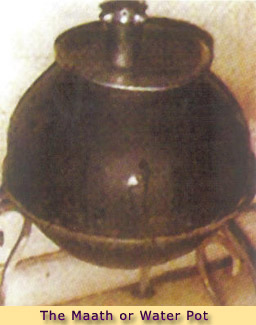
THE MAGICAL CHILLIM (CLAY PIPE)
The Magical Chillim was Baba’s constant companion during his sojourn on
earth. Blessed was the potter who made them, and blessed was the clay that
touched Baba’s hands and lips.
On the right side of the Maath or Water Pot in the corner were a
stack of Chillims’ that Baba had smoked. And next to them in another heap
were new and unused Chillims. Till the year 1930, the Chillims were kept
this way. Now, the unused new Chillims are kept in the Museum in Dixit Wada.
Chandbhai Patil was a truly blessed soul, who got the first taste of
Baba’s Chillim. The bondage between them was great. Baba after smoking and
sharing his Chillim actually went and stayed with Chandbhai. He was
instrumental in brining Baba back to Shirdi, along with his marriage party.

Baba bestowed his grace on many a devotee by allowing them to smoke his
Chillim. The most amazing story is of Balaram Dhurandar (Shri Sai
Satcharitra, Chapter 51). He was troubled by bouts of cough and had asthma
for six years. On his visit to Shirdi he went to the Dwaraka Mai one
afternoon, and with great humility started pressing Baba’s feet. Baba handed
him his Chillim to smoke. Balaram accepted it as Prasad, and took a puff.
The very thought of smoking was painful and alien to him. He had utmost
faith in Baba, so he smoked a while and humbly returned the Chillim to Baba.
Lo! His asthma vanished and he was relieved of the tightness in his
chest. He wasn’t tormented by breathlessness or coughing bouts thereafter.
However, on the day that Baba took Mahasamadhi his asthma was triggered and
he coughed all day. That day and only that day did he cough, and wasn’t
bothered by it again. How could he ever forget the miracle of the clay pipe?
Ganesh S Khaparde was a renowned, wealthy lawyer from Amaravati. He was a
loyal aid of Lokamanya Tilak, who was serving a six-year sentence in Burma.
Baba kept Khaparde in Shirdi and rescued him from the clutches of the
British, who were waiting for a chance to prosecute him for treason and
sedition.
Khaparde was a spiritual man, well versed in Sanskrit, the Shastras
and the Puranas. Time and again during the Arati Baba made mystic signs and
offered his Chillim, when he could unravel the answers. At times the Chillim
calmed his restless mind and gave him reassurance. On 22nd January 1912
Khaparde writes, “During the course of worship he (Baba) put two flowers in
his nostrils, and two others between his ears and head. I thought this was
his instruction, and when I interpreted it in my mind, he offered his
Chillim to me and thus confirmed it”.
Krishnaji Bhishma, the author of Sai Sagunopasana (Arati Book), was
disgusted by the thought of devotees drinking Paad Tirth of a Muslim Sai
Baba. He was horrified to see Brahmin devotees puff the Chillim after Baba
had smoked it, and mentally he resolved not to do both. One day Baba
narrated a story to him. It was the same dream vision that he had had
earlier. While narrating the story Baba usually passed his Chillim to
Bhishma. He took a puff and was thrown into bliss and ecstasy, and changed
for life. At that moment, he became an ardent devotee.
Bhagoji Shinde and Mahalsapati smoked the Chillim with Baba every
morning. Now the Chillim is offered to Baba’s photograph in the Chavadi
during Adkar’s Arati Sai Baba Soukhya Datara Jeeva.
THE HOOKS ON THE CEILING
These hooks are on the ceiling in front of the Nimbar. Nana Saheb Dengle
brought a wooden plank of about 8” wide and 5' in length and gave it to Baba
for sleeping. He thought that Baba could sleep on it instead of sleeping on
the floor.
Baba however tied this plank with old rags to the hooks on the
ceiling like a swing. After lighting four Panthis (earthen lamps), he placed
them in each corner of the plank. Baba The Yogi Raj' then slept on this
plank. One could see him either sitting there with his head bent, or
sleeping on the plank. Many people wondered how he got up and down from this
plank, and tried to watch this leela, but were not successful. Then one day
Baba broke the plank. This leela is described in detail in the Shri Sai
Satcharitra Chapter 10.
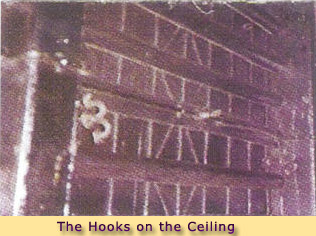
Dasganu says, "The plank hung so close to the ceiling that no one could sit
upright. One could only sit on it bending one's body like an arch. Yet this
great Yogi slept on it"! (Refer Bhakta Leelamrita, Chapter 31).
"Meditate always on My formless nature, which is knowledge
incarnate, consciousness, and bliss. If you can not do this, meditate on My
Form from top to toe, as you see here night and day " said Baba to Dhabolkar
(Ref. ESS. Ch. XVII). Although Baba was surrounded by countless devotees,
Shyama and Mahalsapathi being His constant companions, yet none of them saw
Baba get up or get down the 'swing bed'.
"You thought, that I was in Shirdi, with a body composed of the five
elements and 3 1/2 cubics in length, and not outside of it. Now you see and
determine for yourself whether the person you see here now, is the same you
saw at Shirdi” said Baba to Mankar at Machindragada (Satara district) (Ref.
ESS, CH. XXXI).
"I require no door to enter, I have no form or any extension, I live
everywhere, I carry on as the wirepuller, alter the actions of the men who
trust Me and merge in Me" said Baba to Megha.
Baba is Parabrahma. One who is without birth, body, age and death.
He was, is and will be with us eternally. When that being the case, how
could they see Him in the “Anima or the formless state?”
Devotees who visit Dwaraka Mai today look with wonderment at the
ceiling in front of the "Nimbar" at these hooks.
THE NIMBAR OR ALLAH MIA CHE JAGHA
Upon ascending the central steps (3 steps) of the Dwarakamai Sanctum
Sanctorum, the Nimbar is directly in front. The Nimbar or Allah Mia Che
Jagha (the place of Allah Mia) is the arched structure in the wall. It is in
the western wall of the Dwarakamai next to the ever burning lamps. It is
garlanded daily, and often is venerated with a shawl.
In a Masjid the Nimbar is said to represent the Darga of Mecca. The
devout Muslims do Namaz in front of it. Mention is made of this Nimbar in
several places in the Shri Sai Satcharitra. The Urs started in 1897 and
during that yatra (fair), the “Sandal Procession” also took place. This
procession is held in honor of great Muslim saints. Chandan paste and
scrapings are put in a Thali and carried around the village in procession.
After returning to the Masjid the chandan is pasted with the hands on this
Nimbar. This Sandal procession was started by Amir Shakkar Dalal of Korhla.
Now the descendants of Abdul Baba carry on this tradition. (Refer Shri Sai
Satchritra Chapter 6).
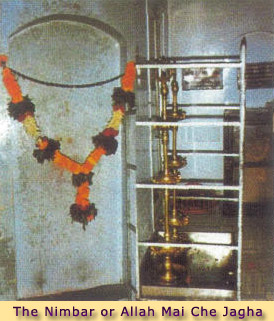
After the Noon Arati the devotees went home. Baba then went inside, and sat behind the curtain, with His back to this Nimbar for his meal. There were two rows of devotees one on each side. After all the Naivedya was mixed together (kaala) and placed before Baba, he consecrated it and offered it to god and everybody dined to their hearts' content. (Refer Shri Sai Satcharitra Chapter 38).
THE EVER BURNING LAMPS
Baba was very fond of lighted Divas (earthen lamps). From the beginning of
his stay in the Dwarakamai, Baba lit divas daily. And they burned
perpetually. Baba celebrated Diwali with numerous lamps. He tore thin strips
of cloth and twisted them and used them as wicks. Often he tore his old
Kafni into thin strips and used it as wicks.
In Shri Sai Satcharitra Chapter 5, the leela of his lighting the
lamps with water is given. One day the grocers refused to give him oil.
Unperturbed He returned to the Dwarakamai. He took the empty tumbler that
had a smidgen of oil in it. He filled it with water and drank it.
Consecrated water and a few drops of oil and offered it to God, and then lit
the lamps. Lo! They burned throughout the night.
The Jyoth has been burning perpetually since then. When the brass
lamps are cleaned the wicks are temporarily placed in another lamp. The oil
dripping from these lamps have healing properties. Numerous devotees have
used it for Arthritis, Migraine, and other ailments with wonderful results.
THE JAATH OR QUERN (HAND MILL)
In the Shri Sai Satchritra, Chapter 1 the wonderful leela of Baba grinding the wheat is described. During the year 1910, One day in the early morning, Baba sat down at the Quern to grind wheat. Four village women saw this; they took the peg of the quern from his hand and started grinding the wheat. While doing this they thought “Baba has no kith or kin and subsists on Bhiksha. So he will give us the flour”. After all the wheat was ground, they divided the wheat into four portions for themselves. Baba then used very foul and abusive language. He said, “Phukat Khau Randa” (free looting prostitute) and told them to take the flour and throw it on the village boundary. At that time, Cholera was raging through out the village. Seven people had already succumbed to the epidemic. This was Baba’s remedy to stop the epidemic. Since then, Cholera has not occurred in Shirdi, although neighboring villages are often afflicted. What was the relationship between Cholera and wheat flour?
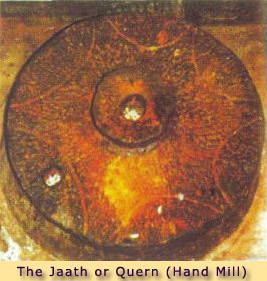
Cholera is called Mahamaari or the great killer. Mahamaari means sure death
every time it strikes. There is no greater fear than the fear of death.
Birth is followed by death at sometime for sure. One who has conquered the
fear of death is immortal. So if one wants to conquer the cycle of birth and
death, then one has to be liberated and free.
If the ultimate goal is liberation then why is one bound? The fact
is that human beings are bound by Karma (actions) and Maya. In fact karma
and maya are inseparably interlinked. They are the two facets of life.
The significance of Quern or Hand Mill
Baba lived in Shirdi for 60 years and he ground the mental, physical
afflictions and the miseries of innumerable devotees. In the Quern, lower
stone represents Karma and upper stone represents Bhakti, and the handle of
the Quern represents Jnana (knowledge) or self realization.
Self realization is not possible unless there is the prior act of
grinding of all our impulses, desires, sins, trigunas and ego. Besides the
philosophical significance and grinding the cholera germs Baba daily ground
sins, mental and physical afflictions and miseries of his innumerable
devotees and he is still continuing to do so.
Once Kabir saw a woman grinding corn and said, “I am weeping because
I feel the agony of being crushed in this wheel of worldly existence, like
the corn”. His guru Nipathiranjana reassured him saying, “Do not be afraid,
but hold tightly the handle of knowledge of the hand mill, and do not wander
far away. Turn inward to the centre and you are sure to be saved”. (Refer
Shri Sai Satcharitra, Chapter 1)
Devotees can see this hand mill in the Dwarakamai entreating Baba to
grind their sins. Another hand mill which Baba used for cooking is kept in
the Museum.
THE SACK OF WHEAT
During Baba’s sojourn in Shirdi, this sack of wheat was kept resting against the wall of the Dwarakamai. Now this sack of wheat is kept in a glass small cupboard, with a glass door next to the hand mill. Balaji Patil Nevaskar rendered selfless seva to Baba, by sweeping and cleaning the streets daily that Baba trod on.
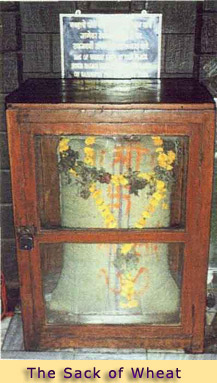
Every year when there was a harvest in his field he would bring the whole quantity of wheat to Baba and maintain his family on whatever Baba gave him. Whether the amount of wheat was large or small did not matter to him as he believed that it belonged to Baba. Baba used to eat Chapattis made out of this wheat. (Refer Shri Sai Satcharitra, Chapter 35). This practice continued till he died. After him, his son also continued the same tradition. The wheat bag used to be replaced on every Ramanavami day by his family. Now the Sansthan has continued the tradition and will replace the old wheat bag with the new one. The old wheat bag is sent to Saibaba Prasadalaya.
THE PORTRAIT OF SAIBABA IN FRONT OF DHUNI MAA (DWARAKAMAI POSE)
This portrait is an oil painting by the famous artist Shyamrao Ramachandra Jaikar. Moreshwar Pradhan had brought Jaikar to Shirdi and requested him to make two portraits of Baba. After Jaikar met Baba, he on his own accord made more than two paintings, at Baba's bidding, when Baba said "Aur Banao Jyada Banao, main guttigulli mein rahnewalla hoon".
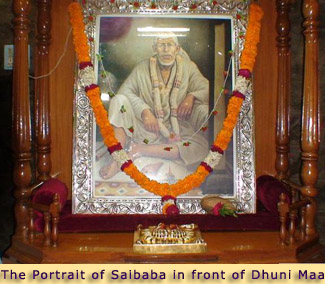
This portrait was presented to the Sansthan after Baba’s Mahasamadhi. It was
installed in the very place where Baba sat. As the portrait was created with
Baba’s consent it has this incredible feature that when a devotee looks at it
with love and devotion, he gets the “living experience” of Baba in it.
Many a devotee has had unimaginable, and innumerable Leelas from this
painting.
The devotees could not leave Shirdi without Baba's permission. When they
wanted
to leave they came to Baba in the Dwarakamai and sought his permission. Baba
gave them Udi and his blessings and they had a safe journey. Even today devotees
go to this portrait, prostrate asking for His permission and then take the Udi
and leave thus having a successful and safe journey.
At present, the original painting done by Shyamrao Ramachandra Jaikar is
kept in
the Museum. The one that is seen now in Dwarakamai is a copy of the original
painting.
This famous and beautiful portrait is a masterpiece and is widely known
as “The
Dwarakamai Baba Pose”.
Every night the priest places a Kalasha filled with water, and a
kerosene oil
lantern that is lit. The portrait is covered with a mosquito net. It is believed
that when a human being sleeps the atman leaves the body and travels about here
and there. Finally, it comes back to the body; water is binding force that helps
it to identify the proper body. The light from the lantern does the same.
The Possible Meaning of the Dwarakamai Pose
Baba is sitting next to the railing, and his silhouette is in the form of a
triangle with the apex at his head with the Bilva leaf on it. It signifies Mount
Meru the above of mother Parvati. So he is the mother calling his children (us)
to come and take refuge in him. The Kakad Arati says, “Tu Shanti Kshamecha
Meru Ho. Tu Bhavarnaviche Taaru Guruvara (You are the mountain Meru of peace
and forgiveness. You are the bark that ferries us across this mundane
existence)”.
By this posture Baba is instructing us to totally surrender at his lotus
feet.
This is done by offering the Pancha Pranas, Arishadvargas, Trigunas,
Karmendriyas and Jnanendriyas represented by the five fingers of the left hand.
Manas, Budhi and Chitta are represented by the three fingers of the right hand
that are not visible. The index finger is pointing down representing Aham (Pride
and Ego). The thumb represents the Sadguru or Parabrahma which is turned in
pointing to himself. It is the Sadguru or Parabrahma who can cleanse the
Jeevatma of all impurities and undesirable traits.
This is total surrender to his lotus feet. He is not only assuring us
but also
promising us (represented by his firmly placed right foot) that he will take us
on his lap, represented by his left foot. Thus, this pose is an assurance that
he is prepared to take us on his lap like a mother, provided we surrender to him
in toto.
THE SILVER COVERED PADUKAS IN FRONT OF BABA'S PORTRAIT
In front of the portrait painted by Shyamrao Ramachandra Jaikar, is a pair of silver covered Padukas. They were mounted in a granite platform about 3” above the floor. After Baba's Mahasamadhi, Shama was staying in the Dixit Wada. The Sansthan was formed and Shama was asked to pay rent. Shama however, left Dixit Wada and took along with him Baba's Padukas and Photograph to his house. The Sansthan requested Shama to return them but he refused at first. Then S.B. Dhumal went to his house with a big procession and Shama handed over all the articles.
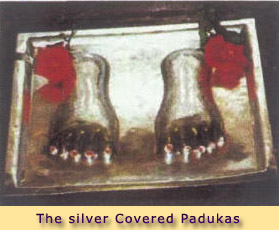
These Padukas are worshipped daily in the morning by the Pujari of the Dwarakamai and decorated with ashtagandh. The Pujari of Samadhi Mandir between comes to the Dwarakamai between 11.30 and 12.00 noon to perform Vaishva Deva Puja. He cleans Baba’s photograph and the padukas and applies fresh ashtagandh. Now these padukas are installed on a pedestal about 3’ high and are covered with gold foil. Devotees offer their “Sashtang Namaskar” to these holy Padukas.
THE KATHADA (RAILING) ON WHICH BABA RESTED HIS HAND
This is the railing on which Baba rested his left hand. Baba sat near the wall
of the Masjid facing south (towards Dhuni) but he did not lean against it. He
always sat upright.
In the north east corner Baba sat in the direction of Ishaanya. His leg
outstretched, showing his blessings on the devotees. There are eight directions
or quarters in this world, each, presided and protected by a deity or Dikpalaka.
Baba sat in the north east corner which is protected by Ishaana whose vehicle is
an Ox. This symbolizes that each individual goes a certain direction, or follows
a certain path that makes or mars his life, according to his vasans. It is lord
Ishaana who guides the world. He will come riding on the Ox or Vrishabha to
exhaust the accumulated vasanas of the jeevas. Thus, Baba sitting in the North
East direction guides the individual in the right direction. Therefore, any Puja
starts with Ashta Digbhandana (the Eight Direction Bondage). Then the mind of
the individual is arrested from taking any particular direction and he discovers
his own true nature.
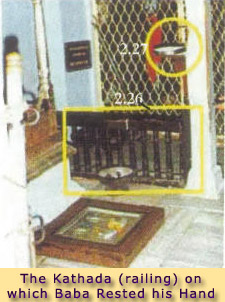
Baba sat facing the south; he is Dakshinamoorthy. The south is the special
domain of lord Yama. Yama means control; it can be self-control, as well as a
limitation over ones’ capacity. The ever smiling, Guru, Saibaba symbolizes the
fact that a man of realization has transcended time. That the Guru’s grace is
being showered on the devotees who are caught in the net of Yama, the lord of
death. The Guru leads the disciple to immortality.
This railing has been painted over and over again but if one lovingly
rests one's forehead on the railing, one can feel a gentle depression where Baba
probably rested His hand. Recently the Sansthan have placed a plastic cover over
the whole railing.
Baba’s Asana
Dixit was concerned about Baba sitting on the cold floor. It got so cold in
winter that it was impossible to stand on the tiles that he had laid. Baba sat
on the floor for hours together. As Baba would not accept a cotton mattress,
immediately he set out and made a mattress of sack cloth. This Baba did not
object to. That evening after his rounds, Baba asked them to remove the
mattress. So every evening Dixit would take the mattress to his Wada, and return
with it early next morning. So the sack mattress became Baba’s Asana.
Baba usually sat on a piece of sack cloth but His bhaktas lovingly
placed a Gaadi over it and bolsters for Him to rest. Baba usually sat with His
legs outstretched and His left hand rested on this railing. (Refer Sai Leela
Magazine, Margashirsha Shake 1857 year 12 (1936)).
THE UDI STAND
The Kathada (railing) is attached to a pillar and to this pillar the Udi stand
or container was fixed. Udi, the sacred ash that came from Baba’s Dhuni Maa was
plentiful and Baba gave a palm full of Udi to his devotees. This Udi is called
as “Angara, Rakh, Bhasma or Vibhuti”. It is the gift of Dhuni Maa. That
wonderful Dhuni Maa that Baba lit when he came to stay in the Dwarakamai.
The meaning of Udi is detachment based on discriminating knowledge. The
literal meaning of Udi is 'to go'. Baba gave Udi to His devotees with blessings
that they should go to a higher plane in their spiritual endeavor.
When Baba was in a cheerful mood he used to sing in a melodious voice
merrily about the sacred Udi “Shri Rama has come. He has come during his
wanderings. And he has brought bags full of Udi”. The Akhand Dhuni Maa is
yielding abundant Udi even now and will continue to do so till the end of time.
(Refer Shri Sai Satcharitra, Chapter 33).
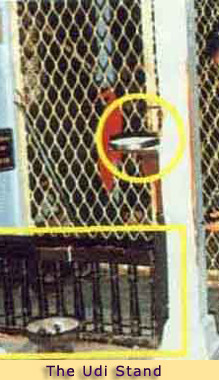
During the early days of his stay in Shirdi, Baba gave medicines to the sick
people without accepting any payment from anybody. But after few years, he
stopped dispensing medicines and started giving Udi instead.
Baba used to give Udi to the devotees after the Arati and also at the
time of departure.
Udi has healing powers, during Baba's time it was used for scorpion
sting, bubonic plague and the 'Jamner miracle,' just to mention a few. The power
of the Udi is as potent as before, and is still curing the diseases and Karmic
impediments. In the Shri Sai Satcharitra, Chapter 33 and 44, the leelas and
greatness of the Udi is given beautifully.
Baba went into the forests around Shirdi and brought wood for the Dhuni
Maa. Sometimes he went to forests far away, and brought huge logs of wood. This
he did himself; there was always a stack of logs near the Dwarakamai. These logs
he fed to his Dhuni, and the ash or Udi he applied to devotee’s forehead.
Vibhuti means “all pervading” or omnipresent. Baba had a unique way of applying
Udi. He often took the Udi between his thumb and forefinger and applied it
exactly in the centre between the eyebrows. This spot is the Trikuti or the
third eye. It is the house of Brahman. Brahman enables you to get
self-realization or realize the true self. This spot is also where the Ajna
Chakra is seated, when the kundalini is awakened. Baba pressed his thumb laden
with Udi on this Ajna Chakra and then drew his thumb in an upward direction.
Baba also used to refer to this spot as the 17th Kala.
In the Prashna Upanishad of Atharva Veda, 6th Chapter, a mention has
been made about 16 attributes of a person known as “Shodasha Kala”. Though a
Purusha is made up of 16 attributes he is perpetually searching for the truth
and wants to realize the atman. He cannot achieve it as he is submerged in Maya.
Only the Sadguru with his grace can show him the right path.
Baba by applying Bhasma or Udi on the Ajna Chakra, the centre of the
principle of the mind, makes the Purusha understand that he is drowned in maya.
And that this transient world will one day be reduced to ashes. Thus Baba is
instructing us to treat Bhasma as a path leading to Vibhuti or the all pervading
(Parabrahma). This can be accomplished through Dharana, i.e., fixing the mind on
him; Dhyana (meditating on him) which results in Samadhi (super conscious
experience).
In order to get released from the bondage of Maya, develop Samyama or
control of the mind by applying Udi.
The word Bhasma means sacred ash, representing the transient nature of
the universe. One day, all existing things will burn to ashes. The wise do not
develop any attachment to them. The use of Bhasma on the body ought to remind us
of the transient nature of the world, so we should contemplate on the permanent
or the Parabrahma.
Devotees may apply this Udi daily and take it as Tirth which will
eradicate their Karma, diseases, fulfill their wishes and help them in their
spiritual path.
BABA'S BATHING STONE
This stone was prepared by Rambaji of Nasik. Hearing of Baba's Leelas he came to Shirdi in a mentally disordered condition. He used to drink Baba's bath water and used it on his body. By doing so he got rid of his mental disorder. As a reminiscence of this he gratefully prepared this stone and offered it to Baba to sit and have bath on it.
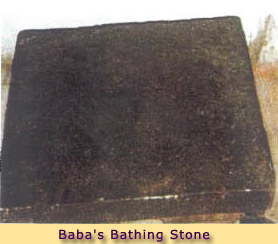
This bathing stone was kept in the verandah of the Dwaraka Mai. After the Museum was opened the bathing stone been housed in the hall on the ground floor of the Museum.
THE THREE STEPS NEXT TO THE OTA OR PLATFORM
The three steps of Dwarakamai lead into the Sanctum Sanctorum. These 3 steps are now used to exit the Sanctum Sanctorum. Whenever Baba went for Bhiksha rounds or to Lendi Bagh and returned, he washed his feet and hands known as Upa Snan on these steps. Many devotees waited for this ritual to complete so that they could collect the water that flowed from his feet as Paada Teertha. This they drank and took home and distributed, for they knew that it would cure many physical and mental afflictions.
THE OTA OR PLATFORM WITH THE AGARBATTI STAND
There is an Agarbatti (incense stick) stand attached to the platform. This platform is on the right side of the main entrance of the Dwarakamai. It is about 8’ long and 3-1/2 ‘ wide and has a height of 2-1/2’. The devotees would offer incense sticks to Baba. Then light them and fix them on this stand.
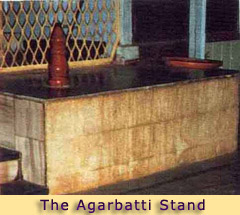
Baba often sat on this platform and distributed Udi after the Noon Arati. There is an original photograph of him sitting on this platform.
THE PALKI ROOM
This room is on the right side of the main entrance of Dwarakamai. Due to the
efforts of Radhakrishna Mai, Shirdi was turned into a Sansthan. In 1912 a Palki,
Rath, many silver utensils and pots were presented. Once this Palki was left
outside and some of the silver ornaments were stolen. The distraught devotees
ran to Baba and complained and Baba simply said "Why did the thieves not take
away the whole Palki?". So Purandhare and Radhakrishna Aai decided to make a
room for it. Purandhare dared to put up the rafters after making five to six
holes in the wall of Dwarakamai for support and the Palki was kept there. This
Palki was presented by Sadu Bhayya Nayak of Harda.
Baba never sat in the Palki, but his photo was placed on it. Every
Thursday at 9.15 PM the Palki is brought in procession to Chavadi.
THE TORTOISE
This marble tortoise is in the center of the well. The black tiles surrounding it represent the four flights of steps leading to the bottom of the well. Numerous meanings are attached to this tortoise. (1) The tortoise is an 'avatar' of Vishnu (Kurma Avatar) (2) That one should enter the place of worship like the tortoise bowing one's head, in complete surrender. Leaving the ego outside just as the tortoise in a prostrate position; one should surrender everything to Baba; (3) But most importantly the tortoise is looking at Baba and if we follow her example and look towards Baba he will surely look after us (Eleven sayings of Baba).
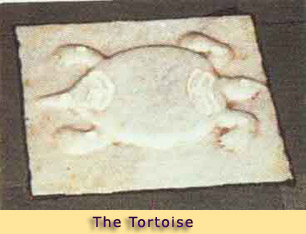
In Chapter 19 of Shri Sai Satcharitra Baba gives the analogy of the tortoise and
says "Just as the mother tortoise feeds her young ones by her loving glances so
was the way of my Guru. The mother tortoise is on this bank and her little ones
are on the other bank. They are nurtured and reared just by her loving glances”.
This tortoise is worshipped with “asthagandh” before “Kakad Aarti” and
after 11.30 AM before “Noon Arati”.
THE TULSI BRINDAVAN
Baba planted this Tulsi Brindavan outside the Masjid. After the outer pavilion was constructed, the devotees brought this Tulsi Brindavan inside and tended to it. It now stands in the North East Corner and is looked after by the Pujari of Dwarakamai. As it is under the roof of the Dwarakamai its nourishment is not up to the mark for lack of sunshine. Every year Tulsi Vivah is done on the 12th day of Diwali.
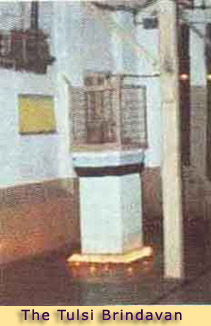
The Mythology of Tulsi Vivaha
On Karthika Shukla Dwadashi which is the 12th day of the bright fortnight of the
month of Karthika (October and November), which is also known as Uthana
Dwadashi, the Tulsi Vivaha takes place.
Jalandhara was a powerful Asura, and was a threat to the Suras or Gods.
The secret of his mighty power was his chaste and devout wife Brinda. The Gods
requested Vishnu to save them; Vishnu impersonated Jalandhara and went to her.
Brinda having lost her chastity, Jalandhara lost his power and met his end. When
Brinda came to know of this she cursed Vishnu. Vishnu then repented and sat next
to her on the funeral pyre of her husband.
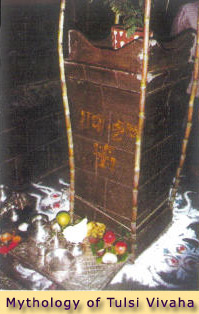
By Parvati’s grace the funeral pyre was converted into a beautiful garden. The
garden was full of Tulsi, Amla (Indian Gooseberry) and Jaie (a type of fragrant
Jasmine). Out of these the Tulsi plant is Brinda. Hence, the garden is known as
Tulsi Brindavan.
Brinda who committed Sati became Rukmini, in her next reincarnation and
married Krishna on Karthika Shulkla Dwadashi.
In Shirdi, Tulsi Vivaha is performed in the Dwaraka Mai on the 12th day
of Diwali. The priests from the Samadhi Mandir come to the Dwarakamai to perform
the marriage. The devotees can participate in the marriage. A new healthy Tulsi
plant is brought and the old one is replaced. The plant is dressed like a bride
in a small green saree. Small green bangles adorn the branches of the plant.
Then the marriage takes place between Krishna and the Tulsi with due rituals.
After the marriage ceremony is completed, the devotees assembled there
are given Bathasa, whole coriander and savouries that are made for the festival
of Diwali. It is a very joyous occasion.
THE IDOL OF SHYAM KARAN – THE HORSE
Kasam, a horse merchant, was distraught because his mare had no issue for a very
long time. He vowed to Baba that if his mare had a foal, he would offer the
first born to Baba. By Baba's grace the mare did have a series of issues. So he
came and presented Baba with the first born. Baba called the horse “Shyam
Karan”as his body was brown while his ears were black.
The horse loved Baba and Baba reciprocated. The trainer Khajgiwalle saw
that the horse was well looked after and decorated. This horse was housed in the
room situated on the eastern side of Dwarakamai; now called “Shyamsunder Hall”.
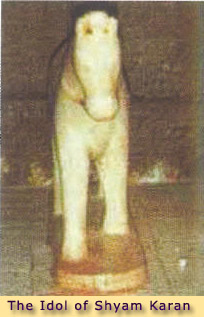
At every Arati the horse would stand in the Sabha Mandap (where the tortoise is
now) and wait patiently for the Arati to start. When the Arati was begun he
danced merrily keeping beat with the tiny bells tied to his feet. After Baba's
Lalkari he would climb the central steps of Dwarakamai and bow to Baba. Baba
blessed him by applying Udi to his forehead, then all the other Bhaktas received
Udi and Prasad.
On Chavadi procession days he was fully decorated with mala, leg rings,
bells and a beautiful cloth for his tail. All his decorative articles are now
kept in the Museum. It was a sight worth seeing as he danced all the way to
Chavadi leading the procession. After Baba entered the Chavadi he stood outside
facing Baba.
After Baba's Mahasamadhi he would dance in the Samadhi Mandir during the
Aratis and also participate in the Chavadi procession.
This beloved horse of Baba died in 1945 and his Samadhi is built by
Saibaba Sansthan in Lendi Bagh.
Bala Sahib Sulthe of Shirdi presented this idol of Shyam Karan. It was
installed on the left side of the stone on which Baba sat.
This statue was in remembrance of the deep love that Shyam Karan had for
Baba and the love that Baba had reciprocated.
THE STONE ON WHICH BABA SAT
This stone is placed in the center of the eastern wall of Dwarakamai near the
Sabhamandap. Baba used to sit on this stone facing west. Marble Padukas were
installed on this stone. Now the marble padukas have been replaced with Silver
Padukas.
Baba often sat in the Sabhamandap. It was the portico in front of the
Sanctum Sanctorum (Dwarakamai). There Baba sat on this stone. First this stone
was adjacent to the Dwarakamai. Later it was moved to the eastern wall.
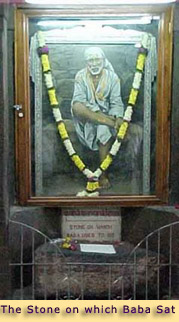
The legend has it, that this stone was in Lendi Bagh. Abdullah, like the other
villagers, used to wash clothes on it. Then they saw Baba sitting on it. So they
brought it to Dwarakamai and venerated it as Baba's Asan.
Once a Pehelvan (Body Builder), who was extremely proud of his strength
came to Shirdi. Baba casually asked him to move the stone, from its original
place to where it is now. But every after trying for a long time the stone did
not budge an inch. The Pehelvan stood silently looking at the stone and then at
Baba. Then Baba laughed and with his Satka played with it as if it was a small
ball. Then with three small steps he moved it to the eastern wall. Needless to
say the Pehelvan was humbled and returned home (Refer Saibaba Hach Chamatkar by
Dr.Keshav B.Gavankar).
THE BIG PORTRAIT OF BABA ABOVE THE STONE
D.D. Neroy of Bombay was a great devotee of Baba. He was a photographer and
artist. He made many photo prints of Baba with one of the eleven sayings printed
below. Usually he would write, "If you look to Me, I look to you ". He sold
these photographs to various Companies and temples.
D.D.Neroy was devoted to Kamu Baba (a saint at Girgaon, Mumbai). He got
this portrait of Baba sitting on the stone made and mounted it in an ornate
frame. Then with the help of four men he took it to Girgaon and offered it to
his Guru. Kamu Baba appreciated the portrait and the kind gesture, but he
refused to accept it. He told Neroy to take it to Shirdi, and place it in the
Sabhamandap of the Dwarakamai. Dejected he sat at his Guru’s feet and said “it
took me three years to make this portrait and one and a half months to get it
framed. Never mind the expense, now you reject it?”. To this, Kamu Baba calmly
said, “It is not a question of rejecting it, but a keen desire that you take it
to Shirdi and place it where thousand upon thousands of devotees will have the
benefit of praying to it”. Thus, this portrait came to be installed in the
Sabhamandap of the Dwarakamai.
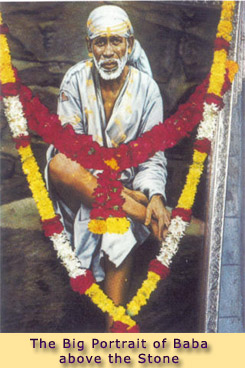
The dimensions of this photograph are 6’ by 4’. Originally it had a wooden
frame, later the silver frame. Recently it has been enclosed in a glass door
cupboard like frame to preserve it. Before Kakad Arati the priest does Alankar
(decorates it) with Ashtagandh and garlands it.
Baba has given Sakshatkar (darshan) from this photo with blessings and
healings.
D.D.Neroy had signed only one photo of Baba and this photo is placed in
the Mangal Karyalay of Sansthan.
THE STATUE OF TIGER
This Statue is on the right side of the stone on which Baba sat. It was
Installed on 12.11.1969 by the Sansthan and presented by Triambakrao Shripathrao
Shiladhar of Ozar village. Seven days before Baba took Mahasamadhi the Leela of
giving a sick tiger Sadgati is vividly described (Refer Shri Sai Satcharitra
Chapter 31). The details are given under the heading “The Samadhi of the Tiger”.
This tiger was brought to Baba with the view to its cure by three
Darveshis. After permission was taken they brought the tiger that climbed the
steps of Dwarakamai, and looked at Baba lovingly. Suddenly it moved the tuft of
its tail and dashed it against the ground thrice and fell and died. With this
Darveshis got upset and Baba gave them Rs.507/- and consoled them. Thus the debt
was paid and it met its end at Baba's holy feet attaining Sadgati. Baba not only
gave Sadgati to men but also to beasts alike.
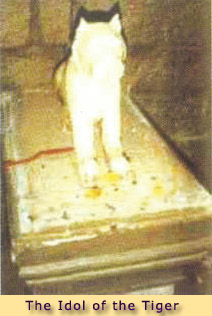
The tiger died in the Dwarakamai at Baba’s feet, then how could he ever be
reborn?
The Samadhi of this tiger is in front of Mahadev temple inside the main
temple complex where in the old Shanti Niwas premises was present.
SHYAM SUNDER HALL
At the end of the Sabhamandap, and behind the stone on which Baba sat is the
Shyam Sunder Hall. It has an east facing entrance, and it was the school where
Shama taught. Shama was an assistant teacher. He often slept in the school at
night. Often at night he heard Baba talk in English, Hindi, Arabic and various
other languages. Shama would look out of the window on the western wall and see
Baba seated alone talking to some invisible entity. He then realized that Baba
is a Sat Purusha.
This hall was later used as a stable for Baba’s beloved horse Shyam
Karan. Then it was used to sieve Udi and store it. Later the sieving was done in
the room adjacent to the Chavadi. Then this room was used as a Parayan Kaksha.
Devotees could read the Shri Sai Satcharitra, do naam jaap or meditate. Then the
Parayan Kaksha was shifted to the room in front of the Kapad Koti in Lendi Bagh.
